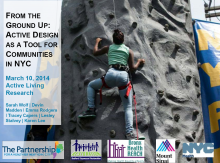We are pleased to announce an exciting new alliance between Active Living Research and GP RED to co-host and coordinate...
From the Ground Up: Active Design as a Tool for Communities in NYC

Presentation at the 2014 Active Living Research Annual Conference.
Background and Purpose
In 2010, New York City (NYC) agencies created the Active Design Guidelines, outlining urban and building design strategies for creating environments that promote daily physical activity. The Guidelines serve as a resource to designers, architects, planners, developers and policy makers. Since 2010, over 2,000 design professionals have been trained on the Guidelines, over 15,000 copies have been distributed and several Active Design policies have been advanced in NYC. Through this work, we recognized that input and strong demand and support from communities is critical for further advancements in, and utilization and ownership of, Active Design strategies. This presentation will highlight two components of community engagement work in NYC to improve built environments for active living: interactive workshops and NYC’s Active Design Guide for Community Groups.
Description
To build community demand and support for Active Design and in recognition that community members are the experts on the facilitators and barriers to healthy living in their communities, the NYC Department of Health and Mental Hygiene (DOHMH) developed a plan for Active Design community engagement work in 2012. Partnering with organizations such as Bedford Stuyvesant Restoration Development Corporation, Bronx Health REACH and Mount Sinai School of Medicine, over 25 interactive workshops reached over 500 participants in communities throughout NYC, with a focus on lower-income communities with high rates of obesity. These workshops had 4 objectives: 1) educate participants about the links between the built environment and active living, 2) provide information about how to access resources that communities can utilize to make communities healthier, 3) provide a venue for residents to collaboratively envision a healthier built environment, and 4) create a space for DOHMH and partners to learn about facilitators and barriers to healthy living from the community’s perspective in order to help us prioritize our efforts. Several built environment ideas generated at the workshops were implemented: students created and installed art pieces above water fountains to encourage drinking tap water at a high school in Manhattan, using a community design process, a playground was constructed at a low-income housing development in Brooklyn, and a vibrant community Play Street was held in the Bronx. Larger community led efforts underway as a result of this work include improving bicycle access on a commuter ferry and expansion of NYC’s bicycle share program into neighborhoods where there are currently no plans to implement. Through these collaborations, we collectively recognized the need for a tool for community groups that outlines the evidence for the health, economic and social benefits of Active Design and the resources available to implement projects that improve the built environment. Thus, we released the Active Design Guide for Community Groups in August 2013, created with input from community partners and other City agencies. The five content areas addressed in the guide are: Active Transportation, Active Recreation, Active Buildings, Green Space and Nature, and Healthy Foods and Beverages. In each section, we describe how the built environment can promote routine physical activity, such as playing, walking and bicycling, in addition to how Active Design can promote other areas of physical and mental health and social and economic vitality and environmental sustainability. Resources for incorporating active design into neighborhoods, streets and buildings are catalogued. Lastly, the “Making the Case” section describes how to access and use data to build support for projects among residents, community partners and local officials.
Lessons Learned
The workshops, and interventions borne out of the workshops, demonstrated that community members are aware of many of the barriers to healthy living, and have creative ideas for improving their communities. However, many community groups are unaware of resources available to make these changes in their communities. We also learned of several barriers to active living whose importance we did not previously recognize, including sanitation conditions such as rat activity, litter and dog waste, and lighting and other built environment factors impacting crime and perceived safety. Learning what communities perceived to be the most important barriers to active living has helped DOHMH and community partners prioritize our efforts.
Conclusions and Implications
We need to ensure resources that support active living are reaching the highest need neighborhoods. DOHMH and partners need to continue to collaborate to maximize our complementary strengths to identify and address barriers to active living in the communities of highest need.
Next Steps
We will continue community outreach and will widely disseminate the Community Guide to ensure that NYC communities are aware of the programs and resources available. Evaluations of the water fountain art installation and the Play Street in the Bronx are both underway. We will continue to evaluate these and other built environment work being undertaken, including processes, costs, and physical activity outcomes and will disseminate results in NYC and elsewhere. Finally, we will take what we have learned from community engagement to inform policy and citywide efforts in partnership with other City agencies and community groups.
References
- NYC Active Design Guidelines
- Active Design Guide for Community Groups
- Active Design: Affordable Designs for Affordable Housing
Support / Funding Source
Centers for Disease Control and Prevention Community Transformation Grant.
- DOWNLOAD "2014_ResearchTranslation1_Wolf.pdf" PDF (3.63 MB) Presentations
Related Tools & Resources
STAY UP TO DATE
RECENTLY ADDED TOOLS & RESOURCES
MOVE! A BLOG ABOUT ACTIVE LIVING
The "Active Living Conference" aims to break down research and practice silos and...







